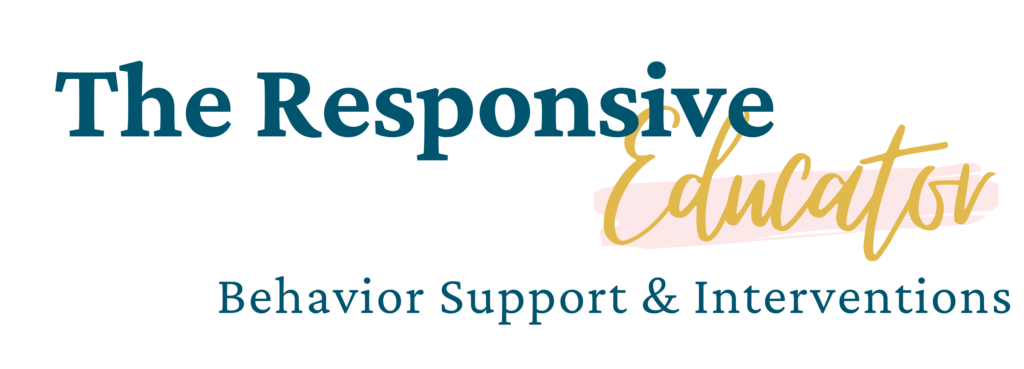
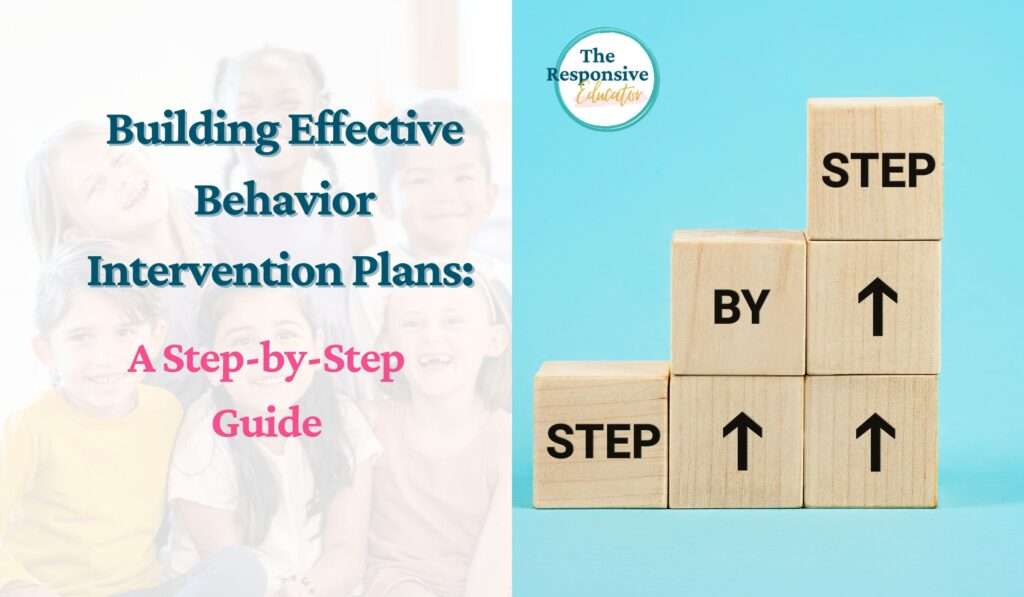
As an educator who works with children who have special needs, you play a crucial role in supporting your students’ academic and behavioral success. One powerful tool at your disposal is the use of behaviour intervention plans (also called behavior intervention plans or BIPs).
BIPs are structured strategy plans crafted by educators to manage and modify challenging behaviors exhibited by students, providing a roadmap for consistent and effective interventions. These plans outline specific techniques, goals, and support systems tailored to individual students’ needs, aiming to foster positive behavioral change and academic progress.

Surprisingly, though, many teachers expected to create BIPs may not have received adequate training. Whether it’s due to a lack of specific instruction or outdated methods taught in sterile college settings, the challenge lies in bridging the gap between theory and practical application when crafting high-quality, individualized BIPs for your students.
In this blog post, we will walk you through each step of building effective Behaviour Intervention Plans. By the end of this post, you will gain a deeper understanding of each of the BIP components and be equipped with the tools necessary to create meaningful, personalized interventions for your students.
Note: I am an Amazon Affiliate. If you purchase products through the links provided, I will earn a small commission at no extra cost to you, which helps support the blog.
Typically found at the top of the first page of behaviour intervention plans, the Student Information section contains the name, grade, school, and teacher of the student. For older students, a homeroom teacher or an advisor may be named. The report’s date and the name(s) of the individual(s) responsible for creating the BIP are also commonly included.
The Student Information Section of behaviour intervention plans might look something like this:

Behaviour intervention plans are crucial documents that help guide educators in supporting students with behavioral challenges. A revision to this plan can significantly impact the student’s progress and success in meeting their goals, so be sure to note the dates of any previous BIPS, as well as to clearly explain the reasons for the revision to help others understand why the changes were made.
There are several reasons why behaviour intervention plans might need to be revised:
When a student makes strides towards their behavior goals, it necessitates a plan update to align with their current needs and strengths. Conversely, if the current plan isn’t yielding results, revisions should target better support and address the reasons behind its ineffectiveness.
Revisions might stem from alterations in the student’s surroundings, such as a new teacher, classroom, or school, or changes in their personal life, such as a relocation, family illness, or the addition of a new sibling. These shifts can impact behavior, warranting a revised plan to tackle emerging challenges.
When revising behaviour intervention plan, it is important to carefully review the existing plan and gather new data to inform any changes. This might include observations of the student’s behavior, feedback from teachers and other professionals who work with the student, and input from the student and their family. By carefully considering the reasons for revision and gathering relevant information, educators can create a revised plan that is more effective in supporting the student’s behavior goals.
The Revisions/Reasons For section of behaviour intervention plans might look something like this:

When creating behaviour intervention plans, it is important to clearly define and describe the target behaviors that need to be addressed. Generally, these behaviors and their definitions are pulled directly from the functional behavior assessment. However, there are times when it makes sense to update a behavior intervention plan with new target behaviors without conducting a new functional behavior assessment.

If the student is exhibiting new target behaviors, but the function of the behavior remains the same (attention, escape, etc.), the behavior intervention plan can be updated without doing a new FBA. However, if the function of the student’s current behavior has changed from the FBA (they used to be trying to gain attention, but now they are trying to escape unwanted tasks), best practices suggest that a new FBA should be completed.
If you need to know more about choosing, prioritizing, or operationally defining target/problem behaviors, you learn more in my post about how to conduct a functional behavior assessment.
The Target/Problem Behavior section of behaviour intervention plans might look something like this:

When writing the Summary/Functional Hypothesis section of behaviour intervention plans, it is important to closely relate it to the same section in the Functional Behavior Assessment. As mentioned above, if the target behaviors have changed since the FBA was written but the function remains the same, the behavior intervention plan can be updated without doing a new FBA.
However, if the function of the student’s current behavior is different from what was named in the FBA, best practices suggest that a new FBA should be completed.
For each target/problem behavior, it is important to summarize the antecedent events or triggers for the student and identify the functional purpose of the behavior. This involves pulling together all of the available data to understand WHY the behavior appears to be occurring. It is important to remember that a behavior can have more than one function. For example, “During math time, Ben hits and kicks other children in an attempt to avoid the task and gain adult attention.”
The Summary/Functional Hypothesis section of behaviour intervention plans might look something like this:
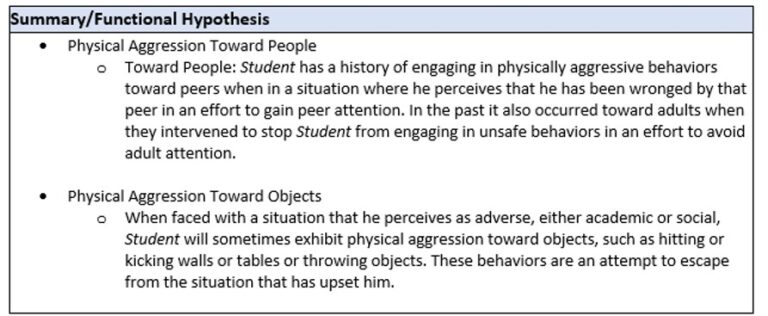
When creating behaviour intervention plans, it’s essential to identify and teach replacement behaviors that are functionally equivalent to the target/problem behavior. This section outlines the process of selecting an appropriate replacement behavior that serves the same function as the problem behavior.
Once you have identified the function of the behavior, you can begin to think about replacement behaviors that would meet the same function in a more appropriate way. For example, if the function of a student’s problem behavior is to gain attention from their peers, a replacement behavior could be asking a question or making a comment related to the class topic during group discussions.
Similarly, if the function of a student’s behavior is to escape from work, a replacement behavior could be asking for a break or a modified task that is less challenging.
It’s important to note that a replacement behavior should not be something that the student is already doing, as this would not be a true replacement behavior. It should also be a behavior that is achievable for the student and can be taught through explicit instruction and reinforcement.
Remember also that if we want to change behavior, we must actively teach the behavior we are hoping to see instead. For this reason, any alternative/replacement behavior outlined in this section should be explicitly taught in the Educative Strategies/Instructional Procedures section of behaviour intervention plans.

As shown in the examples below, there is more than one way to write replacement behaviors for behaviour intervention plans, so feel free to choose the wording that makes the most sense to you.
The Functionally Equivalent Alternative/Replacement Behaviors section of behaviour intervention plans might look something like this:

Proactive Strategies and Antecedent Manipulations are two interchangeable terms that refer to the actions we can take before a problem behavior occurs to reduce the likelihood or severity of the behavior. These strategies are essential components of all behaviour intervention plans, but are often overlooked or neglected.

Implementing proactive strategies can be a powerful way to prevent problem behaviors, motivate students to use replacement behaviors, and help teachers regain instructional time previously lost due to disruptive behavior. Here just a few benefits of preventing problem behaviors vs. reacting to problem behaviors after they have occurred.
Positive Learning Environment: Preventing problem behaviors creates a safe and positive atmosphere for learning, boosting student engagement and a sense of security.
Academic Excellence: By addressing issues early, educators can dedicate more time to teaching, leading to improved academic performance and better learning outcomes.
Minimized Disruptions: Proactive prevention reduces classroom disruptions, allowing for consistent teaching and enhanced instructional time.
Teacher Well-Being: Preventing problems lowers teacher stress, fostering job satisfaction through more effective teaching and positive student interactions.
Incorporating a preventive approach to behavior management in the educational setting ultimately fosters a nurturing, productive, and supportive environment where students can thrive academically, socially, and emotionally.
Antecedent interventions, or proactive strategies, can effectively reduce problem behaviors in the classroom. There are various antecedent manipulations that educators can use to support their students’ behavior. Note that the strategies listed below are just some examples of the range of options available.
Alternative seating is a type of antecedent intervention that involves offering students a choice of where to sit in the classroom. This can include different types of seating arrangements, such as standing desks, wobble stools, bean bags, floor cushions, or stability balls. The goal of alternative seating is to provide students with a comfortable and engaging learning environment that meets their individual sensory needs, while also reducing the likelihood of disruptive behavior.
For example, a student who has difficulty staying seated for long periods of time may benefit from using a stability ball as their seat. The bouncing motion of the ball can provide sensory input and help the student stay focused, while also allowing them to move their body without disrupting the class. Alternatively, a student who has trouble focusing may benefit from a standing desk, which can help them stay alert and engaged in the learning process.
It’s important to note that alternative seating should be offered as a choice, rather than being forced upon students. Giving students a sense of control and autonomy over their learning environment can help them feel more invested in their education and more motivated to behave appropriately. Teachers can also work with students to establish clear expectations for behavior during alternative seating, such as remaining focused on the task at hand and not disrupting others.
Consistent rules and expectations are an essential antecedent intervention that can help prevent problem behaviors in the classroom. When students know what is expected of them, they are more likely to follow those expectations, and they will be less likely to engage in misbehavior. Clear and consistent rules and expectations also help create a more predictable environment, which can be comforting for some students.
To effectively use consistent rules and expectations, educators should take time to establish and communicate the expectations with their students. It is important to discuss the rules and expectations with students, provide examples, and allow for student input to ensure they are understood and relevant to the students. Educators should also model appropriate behaviors and consistently enforce the rules and expectations.

For example, a teacher may establish a rule that students must raise their hands before speaking during class discussions. The teacher can then model this behavior by asking students to raise their hands before speaking during classroom discussions. The teacher should consistently enforce this expectation, reminding students to raise their hands before speaking and providing positive reinforcement when they do so.
By using consistent rules and expectations, educators can create a structured and predictable environment that is conducive to learning and positive behavior. This, in turn, can help prevent problem behaviors and allow for more time to be spent on instruction.
Cool-down strategies are tools that educators can provide to students to help them regulate their emotions and reduce the likelihood of disruptive behavior. These strategies can include calming music, deep breathing exercises, sensory items, or even a designated calm-down area in the classroom.
When students become overwhelmed or anxious, they may struggle to focus on the task at hand and resort to disruptive behaviors such as yelling, throwing objects, or leaving the room without permission. By teaching students cool-down strategies, we can help them learn how to manage their emotions in a healthy way and take a break when they need to.
For example, a student who becomes agitated during group work can benefit from taking a few minutes to listen to calming music or practice deep breathing exercises to help them feel more centered, focused, and ready to work.
Fidgets are small, handheld objects that students can manipulate during class or learning activities. They come in various forms, such as stress balls, therapy putty, or fidget cubes (among many others).

For some students, having a fidget to manipulate with can help them focus on the task at hand or release excess energy in a way that is not disruptive to the learning environment. For example, a student who struggles with impulsivity and frequently interrupts class discussions can benefit from having access to a stress ball or fidget toy to help them redirect their energy in a quiet, non-disruptive way.
It’s important to note that not all students benefit from fidgets, and for some, they may be a distraction. It’s essential to assess each student’s needs and determine if fidgets would be an appropriate antecedent intervention for them. Additionally, setting clear expectations and guidelines for the use of fidgets can help ensure they are being used appropriately and not becoming a distraction for others in the classroom.
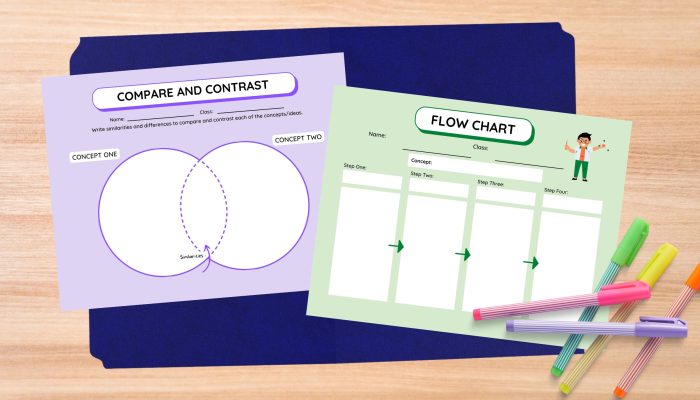
Docu supports, or documentation supports, are visual aids that can help students better understand the material and process information. These supports can include note-taking guides, graphic organizers, study sheets, and other visual aids that provide structure and support for learning.
For example, a note-taking guide can help students organize their thoughts and take effective notes during a lecture or presentation. This can reduce anxiety and help students feel more confident about their ability to understand and retain the material.
Graphic organizers can also be helpful for students who struggle with organizing information. These tools provide a visual framework for information and help students see how different concepts relate to one another. This can help reduce frustration and confusion and make it easier for students to process and remember information.
By providing these types of docu supports, teachers can help reduce the likelihood of disruptive behavior that may result from frustration or anxiety related to learning.

Providing students with opportunities for movement can be a powerful antecedent intervention. Students who have trouble sitting still may struggle to focus or become restless, leading to disruptive behavior. By providing opportunities for movement, such as taking a quick walk around the classroom or engaging in a brief physical activity, students can release excess energy and refocus their attention on the task at hand.
Examples of opportunities for movement could include incorporating brain breaks throughout the day, allowing students to stand up and stretch periodically, allowing them to work standing up at their desks or a back counter, or incorporating physical activity into lessons (e.g., incorporating movement into math problems or using physical actions to help memorize vocabulary words).

Non-contingent positive attention involves giving students positive attention, such as praise and compliments, without requiring them to display any particular behavior. This basically means that they don’t have to do anything to earn it. They are valued simply because they exist. Examples of non-contingent positive attention include saying things like “I’m so glad you’re here today,” or “I like the way you’re listening.”
This approach aims to help students feel valued and appreciated, which can potentially enhance their motivation to exhibit appropriate behavior. Additionally, it plays a vital role in nurturing a strong teacher-student relationship, which is essential for addressing challenging behavior, especially for students who often receive attention mainly when they’re being corrected.
Non-contingent positive attention is a valuable component of a comprehensive behavior intervention plan. It should be integrated with other antecedent interventions and reinforcement strategies. While it’s effective in fostering a positive classroom environment, it should not replace the practice of positively reinforcing specific behaviors.
Offering choices is a powerful antecedent intervention that can empower students and reduce challenging behavior. By providing students with a choice between two or more options, educators can help students feel like they have some control over their environment, which can reduce feelings of frustration or anxiety that may lead to disruptive behavior. This strategy can be used in many different situations, such as choosing between two different assignments or activities, or choosing between different ways to complete a task.

For example, instead of assigning a specific topic for a writing assignment, an educator could offer students a choice between several different topics, each with varying levels of difficulty. Or, when presenting a math problem, an educator could offer multiple ways to solve it, giving students the opportunity to choose the method that works best for them.
By providing choices, educators can tap into students’ interests and strengths, making learning more engaging and effective. Additionally, this strategy can increase student buy-in and motivation, leading to fewer behavior problems in the classroom.
However, it’s important to strike a balance when offering choices to students. While choices can enhance buy-in and reduce behavior problems, it’s crucial to be mindful of not overwhelming certain students. Providing an excessive number of options might inadvertently lead to increased stress and indecision, ultimately hindering their ability to engage effectively. Tailoring the range of choices to each student’s comfort level ensures that the benefits of choice remain a positive and empowering experience for all.
A predictable routine can be a powerful tool in reducing challenging behavior for students who struggle with changes in routine or transitions. It helps students understand what is expected of them and what is going to happen throughout the day. By knowing what comes next, students feel more in control and can better regulate their emotions. This, in turn, can reduce the likelihood of disruptive behavior.
For example, a teacher can establish a consistent schedule for the day, with set times for different activities such as morning meeting, reading time, math class, and so on. This can be posted in the classroom and reviewed with students each day.
Additionally, a teacher can use visual schedules or timers to help students better understand the passage of time and what activities are coming up next. By having a predictable routine, students can focus on their learning and feel more comfortable and secure in the classroom environment.
Precorrection is an antecedent intervention strategy that involves providing students with guidance on appropriate behavior before a potentially challenging situation or task arises. This strategy can be particularly effective for students who struggle with impulse control or have a history of problematic behavior in certain situations.
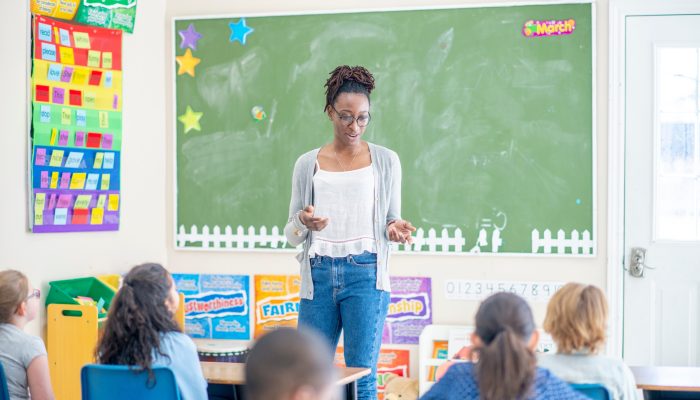
To implement precorrection, educators can identify potential triggers for the problem behavior and provide specific instructions on what the student should do instead. For example, if a student has a history of interrupting during group discussions, a teacher could provide a precorrection by reminding the student to raise their hand and wait for their turn to speak. This can be done in a one-on-one conversation or as a whole-class reminder.
By providing clear and specific guidance on appropriate behavior, educators can help prevent problem behavior from occurring and reinforce positive behavior. Precorrection also helps to establish clear expectations and can reduce confusion or misunderstandings that may lead to disruptive behavior.
Behavior visual supports are a powerful tool to help students understand what is expected of them and monitor their own behavior. They can take the form of visual aids such as picture schedules, behavior charts, and visual cues.
Picture schedules can be used to help students understand what activities are going to happen during the day and what is expected of them. They can be particularly helpful for students with autism or other developmental disabilities, who may struggle with transitions or changes in routine. By providing a clear visual representation of the day’s activities, picture schedules can help students feel more in control and reduce anxiety or stress.
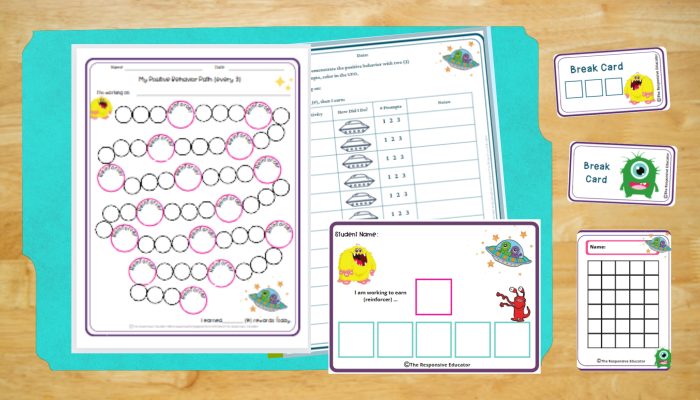
Behavior charts are another common form of visual support. They can be used to track progress towards specific goals or behaviors, with rewards or consequences tied to the student’s performance. For example, a behavior chart might track a student’s progress towards raising their hand instead of blurting out in class. Each time the student raises their hand, they receive a checkmark or other visual indicator of their progress. If they achieve a certain number of checkmarks, they might receive a reward such as extra recess time or a special privilege.
Visual cues can also be used to help students remember specific behaviors or expectations. For example, a visual cue might be a picture of a student with their hand raised, to remind students to raise their hand before speaking. Visual cues can be particularly helpful for students who struggle with verbal communication or who have difficulty remembering instructions.
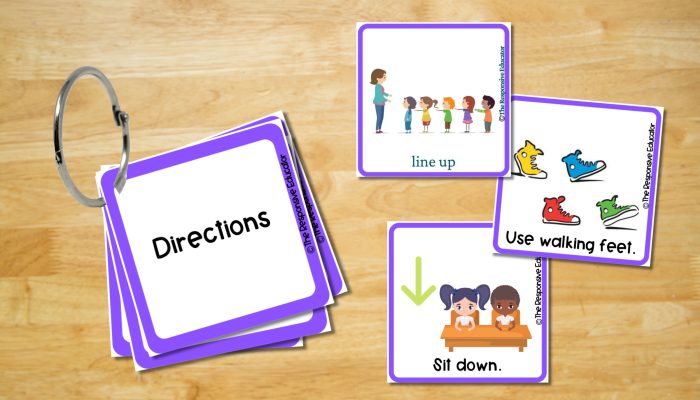
Transitions between activities can be a challenging time for some students, particularly those with attention difficulties or sensory processing issues. Offering transition supports can help make this time smoother and reduce the likelihood of disruptive behavior. By giving students a clear signal that a change is coming, they have time to mentally prepare for the transition and adjust their behavior accordingly.
One example of a transition support is providing students with a visual cue or countdown to indicate when an activity will end and a new one will begin. This can be as simple as holding up a visual card with a picture of a clock or using a timer with an audible alert.
Other students need help conceptualizing the passing of time but are set off by alarms. In this case, visual timers can be great choice. Visual timers offer distinct advantages over traditional timers with audible alarms by providing a clear and constant visual representation of time, fostering better time management and reducing the stress associated with abrupt auditory alerts. Additionally, they promote task pacing and concentration, making them especially effective for individuals with varying learning styles and preferences.
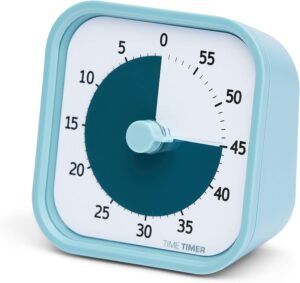
Another example of a transition support is using a consistent routine for transitions. For example, every time the teacher says “time to clean up,” students know they need to finish their activity, put away materials, and line up at the door. By establishing a consistent routine, students know what to expect and are less likely to become confused or anxious during transitions.
In some cases, students may benefit from a sensory break between activities to help them transition more smoothly. This might include a brief period of movement, such as stretching or jumping jacks, or a sensory activity, such as playing with a fidget toy. By offering these types of transition supports, students are better able to regulate their emotions and behavior during times of change.
The Proactive Strategies/Antecedent Manipulations section of behaviour intervention plans may look something like this:
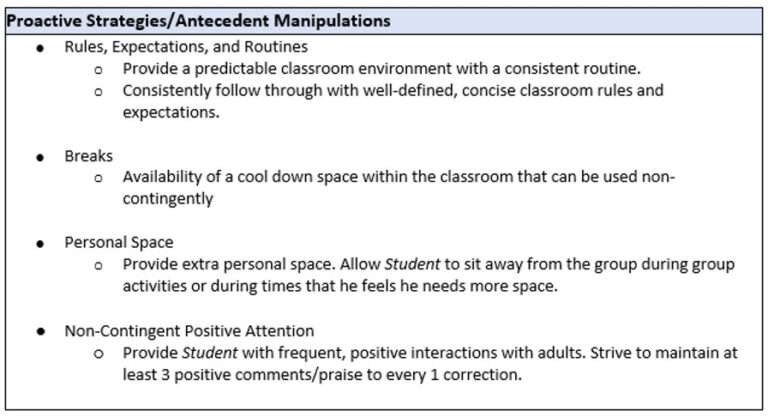
Teaching replacement behaviors through educative strategies and instructional procedures is a key component of behaviour intervention plans. By effectively teaching students how to use replacement behaviors, educators can help reduce problem behaviors, increase appropriate behaviors, and ultimately create a more positive learning environment for all students.
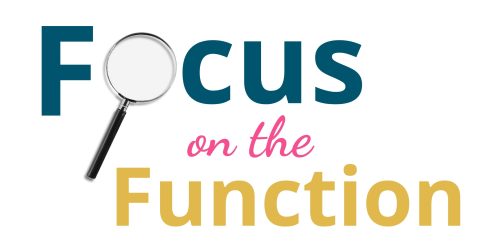
When teaching replacement behaviors to students, it is important to ensure that the function of the behavior is being addressed. If the function of the problem behavior is not matched by the replacement behavior, the problem behavior is likely to continue.
For example, if a student is disrupting class to gain peer attention, teaching them to take a break appropriately may not be effective in reducing the disruptive behavior. Instead, a more appropriate replacement behavior in this case would be to teach the student how to seek peer attention in a more appropriate manner and at a more appropriate time.
In order to effectively teach replacement behaviors, it is important to have a clear plan for the instructional strategies that will be used. This plan should include:
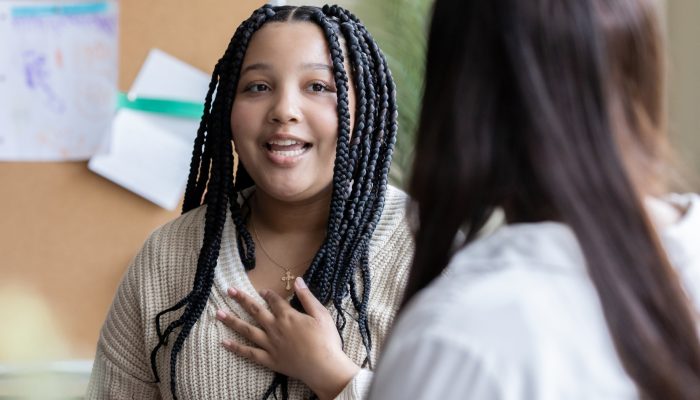
Once you have a plan ready for instructional strategies, it’s time to put it into action with consistency. This means using teaching methods that are proven to work, ones that suit the student’s unique learning style and preferences. Think of positive reinforcement, prompting, modeling, and other techniques that have shown results.
Consistency is the name of the game, across all places and people interacting with the student. It’s important that everyone involved is on the same page and following the replacement behavior instructional strategy.
As you start teaching the new behavior, keep generalization in mind. This means making sure the student can use the behavior not just in one situation, but in many. So, think about different places and times – in class, during lunch, recess, and more. By applying the behavior in various settings, it becomes a versatile skill that truly sticks.
The Educative Strategies/Instructional Procedures section of behaviour intervention plans might look something like this:
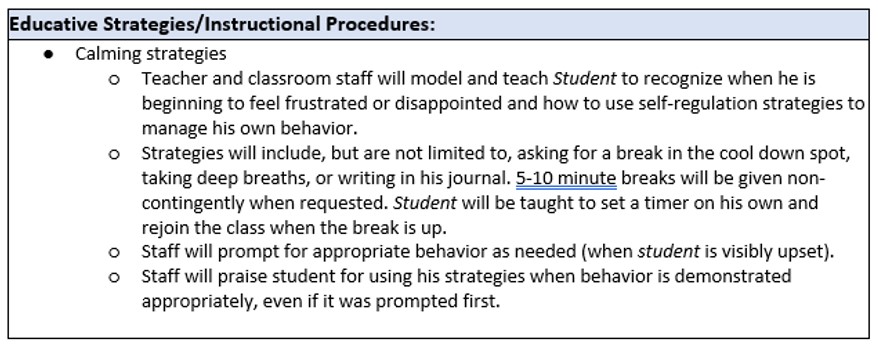
When creating behaviour intervention plans, it’s important to include a Reinforcement Procedures section that outlines how to encourage positive behavior. Reinforcement procedures are incentives that can help motivate students to exhibit appropriate behavior.
Setting and maintaining realistic expectations is essential in this process, allowing for achievable goals and gradual progress. As successes build up, the replacement behavior naturally becomes more intricate and consistent, while the need for external reinforcement decreases.
Here are some key factors to consider when creating a reinforcement plan:
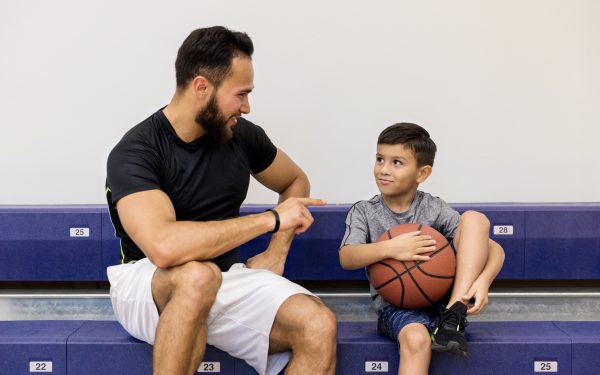
In order for a specific item or activity to be considered a reinforcer, it must be something that the student finds reinforcing. It’s important to remember that what is reinforcing for one student may not be for another. Therefore, it’s crucial to determine what motivates each individual student and what they care about when developing a behavior intervention plan. Reinforcement surveys can be helpful in identifying what students value most.
For instance, while some students may be motivated to earn time playing basketball, others may prefer earning time to read, and some may be more interested in earning time with a preferred person or an edible reinforcer. Ultimately, the key is to determine what is reinforcing for each student and what they are willing to work towards in order to earn that reward.
To determine appropriate reinforcers, it’s important to consider what items, activities, or people might motivate a particular student. Low-cost or free incentives can encourage positive behavior without breaking the bank, but the reward should be enticing to the student and not take too much time away from instruction. A reinforcement survey can be a helpful tool to discover what a student values.
When deciding on a reinforcer, involve the student and try to find something they care about and that you can consistently provide or allow.
For example, I’ve had some students who wanted to work to earn a printing coupon to print a coloring sheet. I would give them the coupon as soon as they earned it, but we had a specific time that they could ask me to print so that it did not interrupt instruction. I have also had students earning coupons for one minute on the computer. Those minutes were saved up and could be spent at specific times in order to minimize the impact on instructional time.
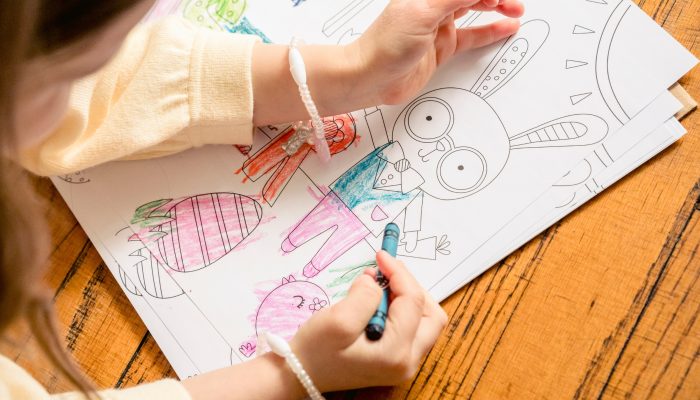
On the other hand, if a student has a hard time waiting, they could possibly work for other things like sitting in the teacher’s chair or a getting few crackers or Skittles. These things could be earned and used without taking time away from instruction.
Remember to consider a student’s age, developmental level, and capacity to wait for an earned reinforcer when deciding how frequently they are able to earn the reinforcement. It does not matter how long we believe that a student should be able to wait for a reinforcer, it only matters how long they actually can wait.
This Forced Choice Reinforcement Survey (not created by me, but FREE) is one commonly used tool to help you determine if your student is most likely to work for Adult Approval, Competitive Approval, Peer Approval, Independent Rewards, or Consumable Rewards. Don’t assume that you already know what the results will be, because the answers will sometimes surprise you.
Once you’ve determined the kind of reward that truly motivates your student, you might find the (FREE) Jackpot Reward Finder on Intervention Central beneficial. This resource enables you to generate customized reinforcement surveys aligned with your student’s preferred reward options.
The tool provides a list of pre-approved rewards to ensure appropriateness, and you can also add your own selections. This compiled list can be printed and discussed with the student, offering them a sense of autonomy in picking their own reinforcers. Despite its somewhat dated appearance, this user-friendly tool remains valuable and practical.

Be clear about what a student must do to earn the reward. Describe the expectations in detail so that there is no confusion about how to earn the incentive. A student should understand that earning the reinforcer is based entirely on their choices and actions and not on the teacher’s feelings about them.
If a student’s plan says that he will earn a break of ten minutes to play basketball if he is able to keep his hands to himself all morning, keeping his hands to himself needs to be the only criteria by which he can earn or lose that privilege. Do not say, “You kept your hands to yourself, but you didn’t do your work and you talked back to me, so you don’t get to play basketball.” This reinforcer is not based on perfect behavior. It is only based on the target behaviors being addressed in the BIP.
If we wait too long to provide students with a reinforcer when they appropriately exhibit the replacement behavior, several potential consequences might arise:
Diminished Effectiveness: Reinforcement is most effective when it closely follows the desired behavior. Delaying the reinforcer can weaken the association between the behavior and the reward, reducing its impact on promoting the targeted behavior.
Loss of Connection: Students may struggle to connect their positive behavior with the delayed reinforcer, leading to confusion about the cause-and-effect relationship. This disconnect can hinder their motivation to continue exhibiting the desired behavior.
Reduced Motivation: Delayed reinforcement might not provide the immediate gratification that students often seek. This delay can diminish their motivation to engage in the desired behavior, as the reward loses its perceived value over time.

Inconsistent Feedback: Immediate reinforcement offers timely feedback that informs students that their behavior is on track. Delayed reinforcement deprives them of this feedback loop, making it challenging for them to gauge whether they’re meeting expectations.
Increased Frustration: Students might become frustrated or disheartened if they’re not promptly rewarded for their positive efforts. This frustration could lead to a decrease in their willingness to cooperate or participate.
Misalignment with Goals: A delay in reinforcement might lead students to prioritize short-term activities over the desired behavior, especially if the alternative activities provide immediate rewards.
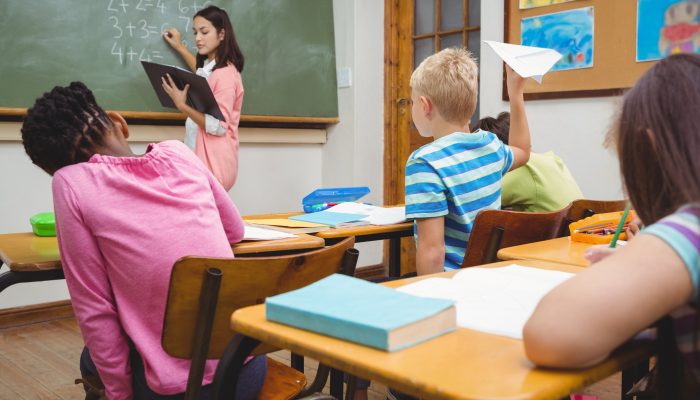
Reduced Learning: Delayed reinforcement may not effectively reinforce the specific behavior students engaged in, making it harder for them to associate their actions with positive outcomes. This could hinder their learning of the desired behavior.
To maximize the effectiveness of a behavior intervention plan, it’s crucial to provide timely and consistent reinforcement for exhibiting replacement behaviors. This reinforces the connection between the behavior and the reward, increasing the likelihood that the desired behavior will be consistently exhibited.
Reinforcement procedures for positive behavior and bribes may seem similar on the surface, as both involve providing something desirable to influence behavior. However, there are important differences between the two concepts:
Purpose: Reinforcement procedures are used to strengthen and increase desirable behaviors over time. They are based on principles of behavioral psychology and aim to encourage positive behavior by providing rewards or consequences.
Timing: Reinforcement is typically provided after the desired behavior has been exhibited. It reinforces the behavior as a consequence of the action.
Consistency: Reinforcement procedures are applied consistently and systematically to promote lasting behavior change. The goal is to create a positive environment that encourages individuals to engage in the desired behavior without the need for continuous rewards. To this end, there should be a goal in place for fading reinforcers over time.

Focus on Intrinsic Motivation: The emphasis is on fostering intrinsic motivation, where individuals engage in the behavior because they find it rewarding, enjoyable, or satisfying in itself.
Positive Relationships: Reinforcement procedures can contribute to positive relationships between the giver of reinforcement (e.g., teacher, parent) and the recipient (e.g., student, child) because they are implemented in a supportive and non-coercive manner.
Purpose: Bribes involve offering something desirable as a means to obtain immediate compliance or to manipulate someone into performing a specific action.
Timing: Bribes are often offered before the desired behavior takes place. They can be seen as a form of persuasion or manipulation to get someone to do something they might not want to do otherwise.
Inconsistency: Bribes may be used sporadically or only when there’s a need for compliance, without a consistent approach to encouraging positive behavior over time.

Focus on Extrinsic Motivation: Bribes rely on external rewards to motivate behavior. The primary goal is to get the person to do something in exchange for the offered incentive.
Potential Negative Effects: Bribes can potentially undermine intrinsic motivation, as individuals may become more focused on the external reward rather than the value of the behavior itself. This can lead to a decreased willingness to engage in the behavior without a reward.
In summary, while both reinforcement procedures for positive behavior and bribes involve providing something desirable to influence behavior, the key differences lie in their purpose, timing, consistency, focus on intrinsic vs. extrinsic motivation, and their potential impact on relationships and long-term behavior. Reinforcement procedures aim to foster lasting positive behaviors and intrinsic motivation, while bribes focus on immediate compliance through external rewards.
The Reinforcement Procedures Section for behaviour intervention plans may look something like this:
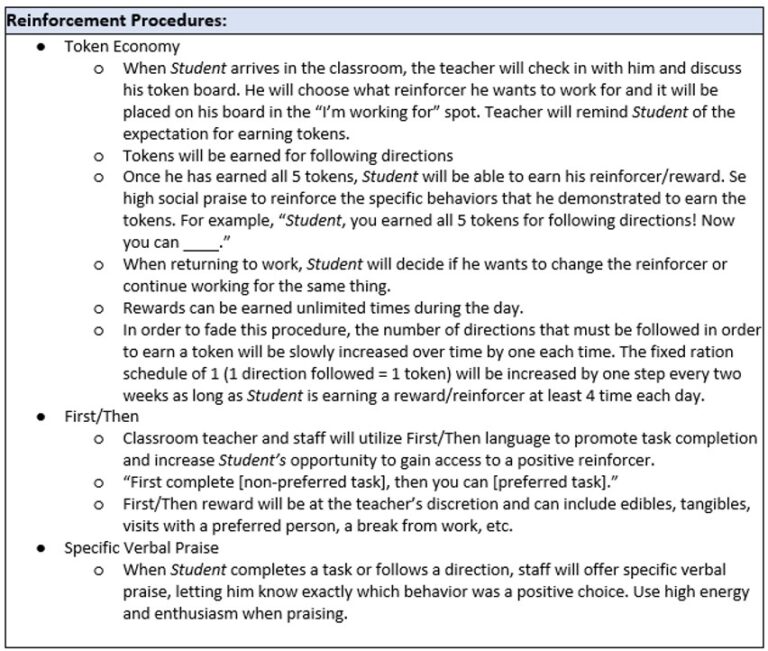
Correction or extinction procedures in behavior intervention plans are designed to reduce problem behaviors by tackling their underlying causes and responding in a way that doesn’t accidentally reinforce them. This is achieved by identifying why the behavior is happening and then choosing a response that clashes with the problem behavior, making it so that the behavior no longer achieves the same goal for the student.
While this section can be called “correction procedures” or “extinction procedures” depending on the BIP form, these two terms do not actually mean the same thing.

When a student engages in a problem behavior, correction procedures can be used to reduce the likelihood of the behavior occurring again. Correction procedures can include verbal corrections, redirections, or reminders of expected behavior.
For example, if a student is talking out of turn during a lesson, a teacher might use a verbal correction such as saying “Please raise your hand if you have something to say.” This reminds the student of the expected behavior and redirects them to the appropriate way of communicating in class.
Correction procedures for ongoing or significantly disruptive behaviors often necessitate a more comprehensive approach. Consider a student who consistently attempts to evade ELA. Imagine the student’s recurring behavior frequently disrupts reading lessons, and as a result, they are sent out of the classroom to a separate space. This escape from the reading lesson is reinforcing their behavior because they get to avoid something they don’t enjoy.
To implement a strategy that removes this reinforcement, the behavior intervention plan correction procedure could involve the following steps:


The aim of this approach is to reshape the reinforcement pattern. Instead of the disruptive behavior leading to a complete escape from the reading lesson, it guides the student toward an adjusted activity that offers a brief respite while still keeping them engaged in the learning environment. Over time, this alteration can diminish the motivation behind the disruptive behavior, as the previous pattern of escape loses effectiveness.
It’s essential to acknowledge that when a student’s behavior has consistently allowed them to avoid reading lessons, there might be a temporary surge in the behavior’s frequency (referred to as an “extinction burst”). During this phase, the student may intensify the behavior in an attempt to achieve the outcome they’ve always obtained (escaping reading). However, as they recognize that the behavior no longer yields the desired result, their behavior can begin to move in a more positive direction.
In some cases, the problem behavior may be maintained by reinforcement from the environment, such as attention from the teacher. One commonly used practice to address this behavior is the use of extinction. When employing extinction, the idea is that the inappropriate behavior will be completely ignored, while positive attention will be given for appropriate behavior to guide the attention-seeking student to seek attention in a more appropriate way.
As with correction, it is important to note that extinction procedures may lead to an initial increase in the problem behavior before it decreases, as the student may engage in the behavior more frequently in an attempt to obtain the reinforcement that is no longer being provided.
While extinction procedures can be effective in reducing problem behaviors that are maintained by reinforcement from the environment, there are situations where it may not be appropriate to use them. Here are some examples:

Safety concerns: If the problem behavior poses a safety risk to the student or others, extinction procedures should not be used. For example, if a student engages in aggression toward others, it is clearly not safe to ignore the behavior.
Developmental level: Extinction procedures may not be appropriate for young children or students with developmental delays who may not understand the change in reinforcement. In these cases, other strategies, such as positive reinforcement, may be more effective.
Function of behavior: If the function of the behavior is not attention-seeking or escape-maintained, extinction procedures may not be effective. It’s important to determine the function of the behavior before deciding on a course of action.
It is important to mention that some people are opposed to using extinction procedures as a correction for inappropriate behaviors due to a variety of ethical and practical concerns. Here are some reasons for the opposition:

Emotional Impact: Implementing extinction can result in a surge of frustration and emotional distress in the individual, especially when they’re accustomed to receiving reinforcement for the behavior. Critics argue that subjecting someone to this kind of emotional turmoil can be detrimental to their overall well-being.
Potential for Escalation: In some cases, when a person’s behavior is met with complete lack of response or reinforcement, they might escalate their behavior in an attempt to regain the attention they’re used to. This escalation could potentially lead to more intense or unsafe behaviors.
Ethical Considerations: Critics raise ethical concerns about deliberately withholding reinforcement, which can be seen as depriving the individual of necessary social interactions, attention, or other forms of reinforcement that contribute to their quality of life.
Lack of Generalization: Extinction might not effectively generalize to all settings or situations. Behaviors suppressed through extinction in one context may re-emerge in other settings where extinction wasn’t applied, leading to a limited impact.
Need for Support: Individuals with challenging behaviors often require additional support and alternative strategies beyond simply removing reinforcement. Critics argue that relying solely on extinction might neglect addressing underlying causes or teaching alternative, more appropriate behaviors.
Long-Term Effects: Concerns exist about potential long-term effects of using extinction, especially if not applied correctly. Some critics worry that repeated use of extinction without addressing the root causes of the behavior could lead to the emergence of new problem behaviors.

Alternative Approaches: Many behavior professionals advocate for more positive and proactive behavior intervention strategies that focus on teaching and reinforcing desired behaviors rather than solely relying on punishment-based methods like extinction.
It’s important to carefully consider the individual student’s needs and situation before implementing extinction procedures for inappropriate student behavior. Consulting with a behavior specialist or other professionals can help ensure that the chosen strategies are effective and appropriate.
Consistency is key in correction and extinction procedures. It is important to respond to the problem behavior in the same way every time it occurs and to reinforce appropriate behavior consistently. Reinforcement can be in the form of praise, tangible rewards, or other positive consequences that are meaningful to the student.
For example, if a student is struggling with staying on task, the teacher may praise the student for completing a certain amount of work within a designated time period, and provide a small reward such as a sticker or extra free time. Consistent reinforcement of appropriate behavior can help to increase the likelihood of the behavior occurring again in the future.
The Correction/Extinction Procedures section of a behaviour intervention plan may look something like this:
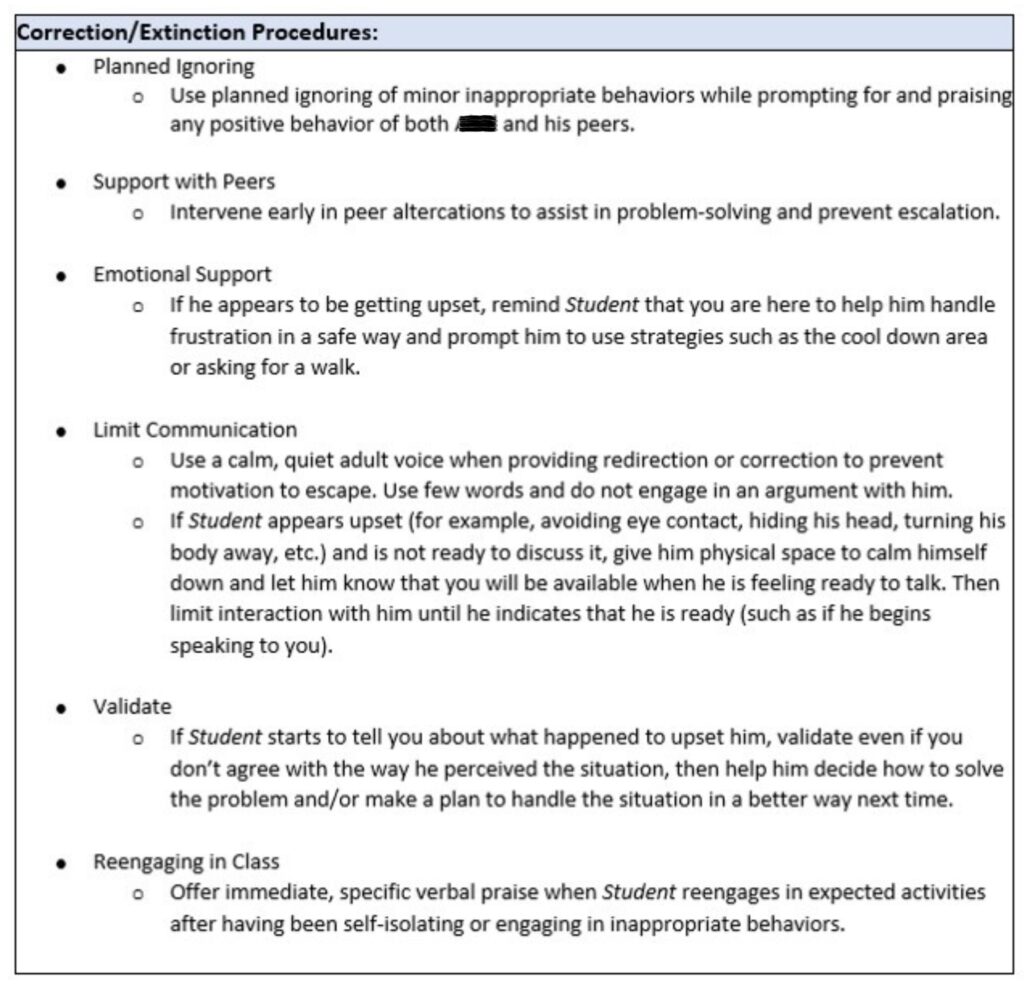
A Crisis Plan is an essential component of behaviour intervention plans that outlines a set of predetermined steps to take when a student exhibits behaviors that pose a threat to themselves or others. It provides a plan of action that outlines how to respond to an emergency situation and ensures that everyone involved knows what to do.
The Crisis Plan is a reactive plan that should be created in advance if needed, but used only as a last resort or in an emergency. It focuses on the immediate elimination of dangerous behavior and outlines an agreed-upon approach to stopping the behavior. The plan must be designed to ensure the safety of the student and others involved, and all stakeholders must be aware of the plan’s details.

A Crisis Plan is needed when a student’s behavior presents a danger to themselves or others. Some examples of when a Crisis Plan might be necessary include:
Physical Aggression: If a student becomes physically aggressive and poses a risk of harm to themselves or others, the Crisis Plan outlines the steps to follow, such as how to protect everyone involved and how to de-escalate the situation.
Suicidal Ideation: If a student expresses suicidal ideation, a Crisis Plan will detail how to ensure the student’s safety, including calling emergency services or providing appropriate counseling resources.
Elopement: If a student tries to leave the school building or campus, a Crisis Plan will detail how to locate and bring them back safely.
Medical Emergencies: If a student experiences a medical emergency such as a seizure, a Crisis Plan will outline the steps to take to ensure the student’s safety and to notify emergency medical services.
When developing a Crisis Plan, it is important to involve all stakeholders, including the student, parents, teachers, counselors, and administration. The plan should be customized to the student’s needs and should consider any potential triggers that may lead to crisis situations.
In addition to a clear (observable, measurable) definition of the problem behavior, the Crisis Plan should include the following elements:
For example, if a student is prone to physical aggression during moments of frustration, the plan might specify that a staff member should immediately escort the student to a designated safe space, while another staff member contacts the school’s crisis team and the student’s parents or guardians. The plan might also outline specific de-escalation strategies or techniques to use with the student to prevent the situation from escalating further.
A detailed plan of action is a critical component of a Crisis Plan. It should outline the steps that educators and staff should take in response to a specific crisis situation, including who should be contacted and how to ensure the student’s safety. The plan should be detailed and specific, leaving no room for confusion or misinterpretation in the heat of the moment.
By having a detailed plan of action, educators can respond quickly and effectively to crisis situations, ensuring the safety of both the student and those around them.

In addition to outlining the steps to take during a crisis situation, the Crisis Plan should also include a communication protocol that specifies how relevant stakeholders will be notified about the situation. This is important because effective communication can help to ensure a coordinated response and prevent misunderstandings that can exacerbate the situation.
For example, the Crisis Plan might specify that the teacher in charge of the student should immediately notify the school counselor and principal in the event of a crisis situation. The counselor may then be responsible for contacting the student’s parents and the school resource officer, while the principal may be responsible for coordinating with any outside emergency services that may be necessary.
Having a clear communication protocol in place can help to ensure that everyone involved in the crisis response is on the same page and has the information they need to respond effectively. It can also help to minimize confusion and anxiety among stakeholders, including the student and their family.

The debriefing process is a critical component of the Crisis Plan, as it provides an opportunity for the team to reflect on the incident and identify areas for improvement. During the debriefing process, team members should discuss what happened during the crisis, what actions were taken, and the effectiveness of the Crisis Plan. They should also identify any areas where the plan was not effective and discuss potential changes to improve it.
For example, if a student with a history of aggression became violent during a crisis situation, the debriefing process may reveal that the Crisis Plan did not adequately address the student’s triggers or warning signs. As a result, the team may decide to revise the plan to include more specific strategies for identifying and responding to these warning signs.

It is important to note that the debriefing process should be conducted in a non-judgmental and collaborative manner. Team members should focus on identifying solutions and making improvements rather than placing blame or criticizing each other’s actions. By approaching the debriefing process in this way, teams can work together to create a more effective Crisis Plan and improve the safety of all students and staff members involved.
The Crisis Plan section of behaviour intervention plans might look something like this:
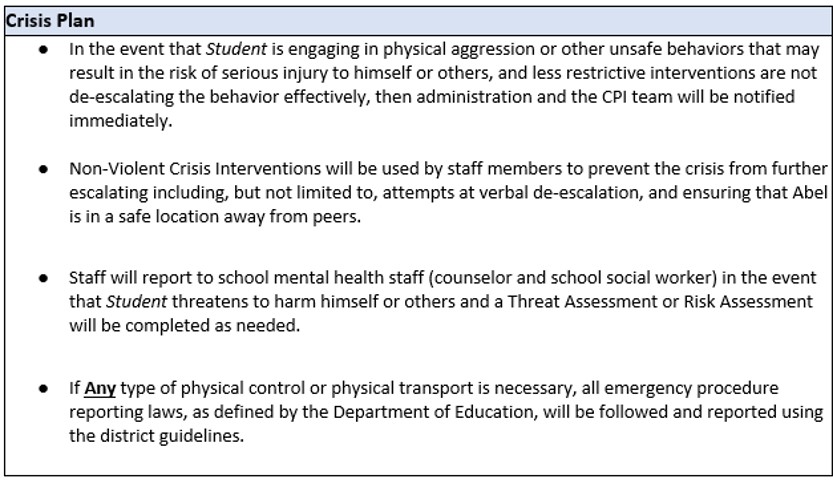
Implementing behaviour intervention plans requires proper training and resources for all staff involved in supporting the student. This includes teachers, paraprofessionals, counselors, and other support staff. Training should include an overview of the plan, including the student’s specific behaviors, strategies, and goals. It should also cover the procedures for data collection and progress monitoring.
Additionally, resources such as visual aids, task analysis sheets, and reinforcement materials may be necessary to ensure the successful implementation of the plan. It is also important to have access to appropriate technology, such as assistive technology devices or communication devices, if needed to support the student’s behavior and academic success.
Training and resources related to behaviour intervention plans should be delivered by a qualified professional who has expertise in behavior management and intervention. This may include a behavior specialist, behavior analyst, special education teacher, or other trained professional. Training can be delivered through a variety of methods, such as in-person workshops, online courses, or webinars.

Documentation of trainings and interactions with teachers and staff is crucial in ensuring that everyone is aware of the behavior intervention plan and their roles in implementing it. Unfortunately, it is not uncommon for staff to claim they were unaware of a student’s plan or their responsibilities in supporting that student. Even after training, some individuals may deny ever having been trained.
To avoid these situations, it is essential to have a system in place to document all conversations, trainings, and consultations with staff. This documentation can include a training signature form or having trained personnel sign and date the behavior intervention plan and placing a copy in the student’s special education physical or digital file. Additionally, it is essential to retrain staff anytime changes occur in the plan or at regular intervals to ensure that everyone is up-to-date on their responsibilities.
The Implementation/Training/Resources section of behaviour intervention plans may look something like this:
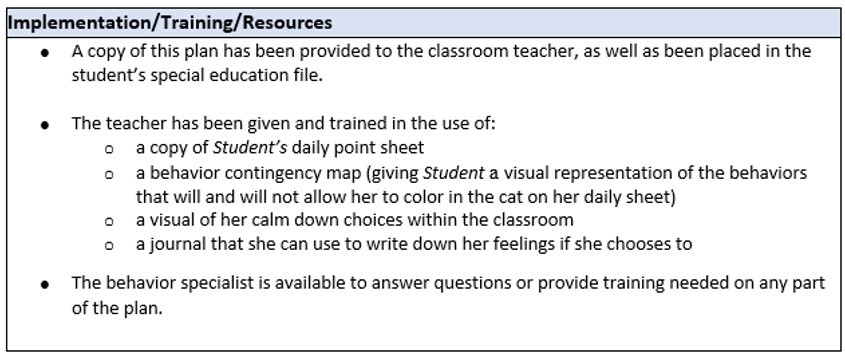
As a helpful resource for educators, we are offering a free download of our Training Acknowledgement and Verification form. Simply print one per student and track your conversations, trainings, and consultations with staff. The form should be printed any time you write or update a BIP. Once you have trained staff on the plan, have them sign and retain this form for your records. This is a crucial step in ensuring that everyone is on the same page and implementing the plan as intended. Click here to download this free resource today!
Behavior Intervention Plans (BIPs) play a crucial role in supporting students with challenging behaviors. However, the mere presence of a plan is insufficient. It’s essential to continuously monitor its effectiveness and ensure faithful implementation. Effective data collection and utilization are key tools for educators to track progress, make informed decisions, conduct fidelity checks, and document a student’s behavior journey.

To gauge the efficacy of a behavior intervention plan, educators can collect various types of data:
Progress Monitoring Graphs: Visual representations of behavior data collected over time. These graphs highlight patterns and progress, aiding in the modification and adjustment of the intervention plan.
Daily or Weekly Behavior Sheets: These sheets assist in tracking targeted behaviors with specific details, helping educators identify patterns and make necessary adjustments to maintain plan effectiveness.
Self-Monitoring Forms: Empowering students to track their own behavior, pinpointing when they are most likely to engage in the target behavior.
Fidelity Checks: The next section will get you up to speed on everything you need to know about conducting fidelity checks.
I have a variety of easy-to-use resources available in each of the categories above. Click on the category name to check them out! Also, to learn more about monitoring behavior, see my posts on behavior measurement.
The Data Collection/Plan Monitoring section of behaviour intervention plans may look something like this:
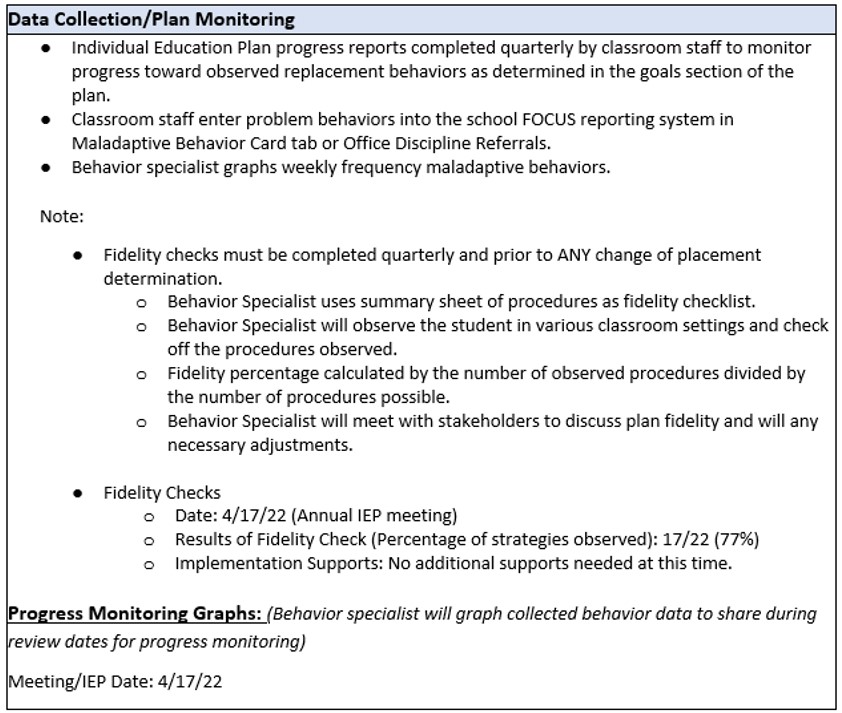
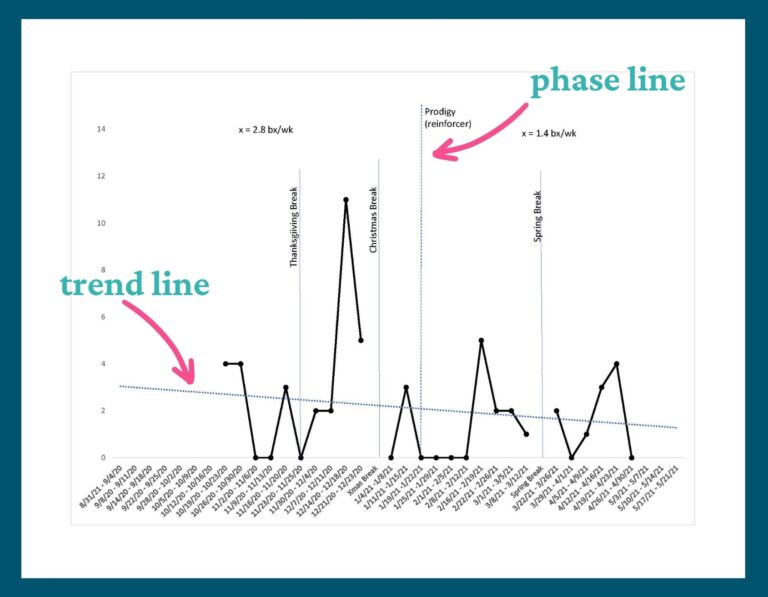
As discussed above, fidelity checks are a crucial component of monitoring behaviour intervention plans. They ensure that the plan is implemented as intended, with consistent adherence to the procedures outlined in the plan. Here’s what you need to know:
When conducting a fidelity check, it’s important to have a clear understanding of the specific procedures outlined in the behavior intervention plan. This includes understanding the goals of the plan, the strategies and techniques to be used, and the specific behaviors being targeted. The observer should also be familiar with the student’s typical behavior patterns and any potential triggers for the challenging behavior.
During the fidelity check, the observer should observe the student in their natural environment and track which procedures are being implemented and how often. This can be done through direct observation, video recording, or other means. The observer should compare the actual implementation to the procedures outlined in the BIP and note any discrepancies.

For example, if the BIP includes a strategy of providing the student with a break when they become agitated, the observer should note whether this strategy is being implemented as intended. They may track how often the break is provided, how long the break lasts, and whether it effectively reduces the student’s agitation.
By conducting fidelity checks, educators can ensure that the BIP is being implemented consistently and with the correct level of intensity. This helps to maximize the effectiveness of the intervention and improve outcomes for the student.
Calculating fidelity involves comparing the implementation of the behavior intervention plan to the plan itself. The observer needs to determine how closely the plan is being followed, which is typically measured as a percentage of the procedures implemented compared to the total number of procedures in the plan.
For example, if the BIP includes five procedures and the observer notes that all five were implemented during the observation, then the fidelity score is 100%. If only four out of five procedures were implemented, then the fidelity score is 80%. The goal is to achieve at least 80% fidelity to ensure that the intervention is being delivered as intended and has the best chance of being effective.
Once the fidelity score is calculated, educators can review the data to identify areas where improvements can be made. If certain procedures are consistently not being implemented, educators may need to revise the plan or provide additional training to ensure that the plan is being implemented correctly.

If the fidelity check indicates that the plan is not being implemented with at least 80% fidelity, it is important to identify the reasons why. This can be done by observing the implementation of the plan or through interviews with staff members responsible for implementing the plan. Once the reasons for low fidelity have been identified, a plan can be developed to address these issues.
One common reason for low fidelity is that staff members may not fully understand the procedures outlined in the plan. In this case, additional training or professional development may be necessary to ensure that staff members are implementing the plan correctly.
Another reason for low fidelity could be that the plan is not feasible or appropriate for the student’s needs. In this case, it may be necessary to revise the plan or develop a new plan that is better suited to the student’s needs.
It’s important to remember that behavior change takes time and that it’s important to give a consistently implemented strategy time to work. At a minimum, it is recommended to give the plan three weeks to start working, preferably 5-6 weeks, before making any adjustments to the plan.
Fidelity Checks may look different depending on the program used by your district. Sometimes they are embedded within the BIP under each procedure section, while other times they are found within a separate document.
We know that fidelity check would need to check off all of the procedures listed in the BIP (antecedent, instructional, etc). These examples, however, only show the Antecedent Manipulation section of the BIP for the purpose of demonstrating the difference between an embedded fidelity check and one that is found in a separate document.
Embedded:
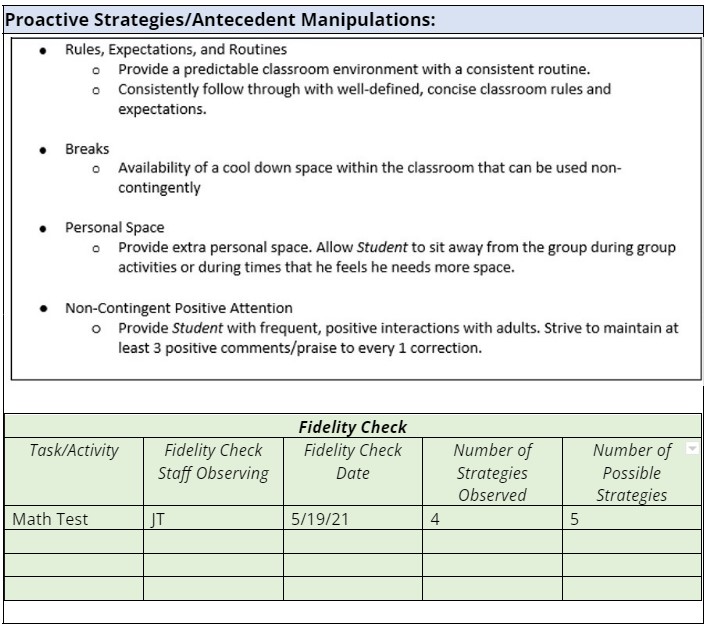
Separate Document:
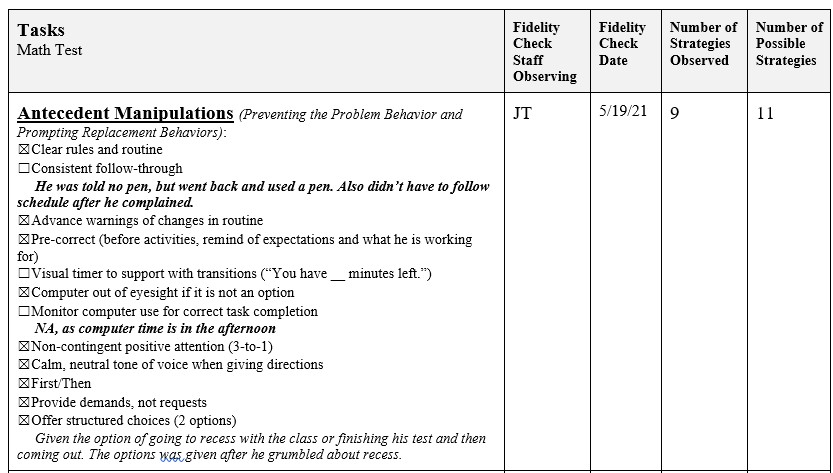
Given the choice, I tend to prefer the second format of fidelity checks in behaviour intervention plans because of the presence of checkboxes for each procedure. It may take an extra step to have the procedures listed on the fidelity check (depending on the program your district uses) but it makes it easy to check off when you see strategies used, as well as easy to see which strategies the teacher may be missing and need additional training on.
When creating behaviour intervention plans, it is essential to consider what criteria need to be met for the plan to be dismissed. Having a clear and well-defined exit strategy ensures that everyone involved in the student’s care is aware of the expectations for the plan’s discontinuation.
Determining the exit criteria can vary depending on the student’s specific needs, goals, and progress. Some examples of when to consider dismissing a BIP may include:

Consistent progress refers to a student’s ability to maintain positive behavior changes over time. When a student consistently demonstrates positive behavior change and improvement, it may be appropriate to consider dismissing the behavior intervention plan.
However, it is important to make sure that the progress is sustained over an extended period of time and that the student does not regress to previous behavior patterns. This may involve ongoing monitoring of the student’s behavior and data collection to ensure that the positive changes are sustained and that the student continues to meet their academic and behavioral goals.
If the student’s progress is maintained, the team can then consider discontinuing the BIP and transitioning the student back to the general classroom environment.

Achieving goals is an essential component of behaviour intervention plans. The team should set specific, measurable, and achievable goals for the student to work towards. As progress is monitored, adjustments can be made to the BIP to ensure that the student is moving in the right direction toward achieving their goals. Once the goals have been met, the team can discuss discontinuing the BIP.
For example, if a student’s target behavior is to reduce the frequency of disruptive behavior in the classroom, the team may set a goal to have no more than two disruptions per day. As the BIP is implemented and progress is monitored, the student’s disruptive behavior decreases over time. When the student consistently demonstrates no more than two disruptions per day, the team may consider discontinuing the BIP.
It is important to note that the team should not discontinue the BIP abruptly but should gradually phase out the plan while continuing to monitor the student’s behavior. This allows for a smooth transition while ensuring that progress is maintained.

As students grow older and transition to different grades or age groups, their behaviors, social dynamics, and learning environments may change. These changes may impact the effectiveness of the current BIP, and it may need to be updated or discontinued.
For example, a student who struggled with attention and focus in middle school may develop more mature executive functioning skills in high school and may no longer require a BIP. Alternatively, a student may need a new BIP to address new behaviors that arise as they move into a new grade level or learning environment.
It is important to regularly reassess the need for a BIP to ensure that it remains relevant and effective for the student. The team responsible for developing and implementing the BIP should monitor the student’s progress and behavior, and consider factors such as age, grade level, and changes in the learning environment. If the student’s behavior has improved or if the BIP is no longer appropriate for their current needs, the team may decide to modify or discontinue the plan.
The Exit Criteria/Plan Dismissal section of behaviour intervention plans may look something like this:

A student who has shown sufficient progress through a Behavior Intervention Plan (BIP) may reach a point where the plan is deemed unnecessary and is discontinued. However, instances can arise where significant disruptive events occur outside of the school environment, affecting the student’s behavior and ability to manage stress within school and their progress experiences a set-back. In such cases, the team may want to reinstate the BIP to provide the necessary support and guidance, helping the student regain their positive trajectory and effectively navigate challenging situations.
Crafting effective Behavior Intervention Plans is a skill that develops with experience and understanding. By embracing the insights discussed in this blog post, you can enhance your ability to translate theory into practical solutions, fostering interventions that genuinely influence your students’ experiences.
As you move forward, remember the importance of flexibility and adaptability. Every student’s plan is as distinct as they are, and the path to successful behavior intervention is a continuous learning journey, both for our students and ourselves.

Support your students’ individual needs with our exclusive Classroom Concerns Checklist.
Identify key concerns in areas like:
…and more to help drive collaboration and problem-solving.
Sign up now to receive instant access and valuable insights on addressing classroom concerns.
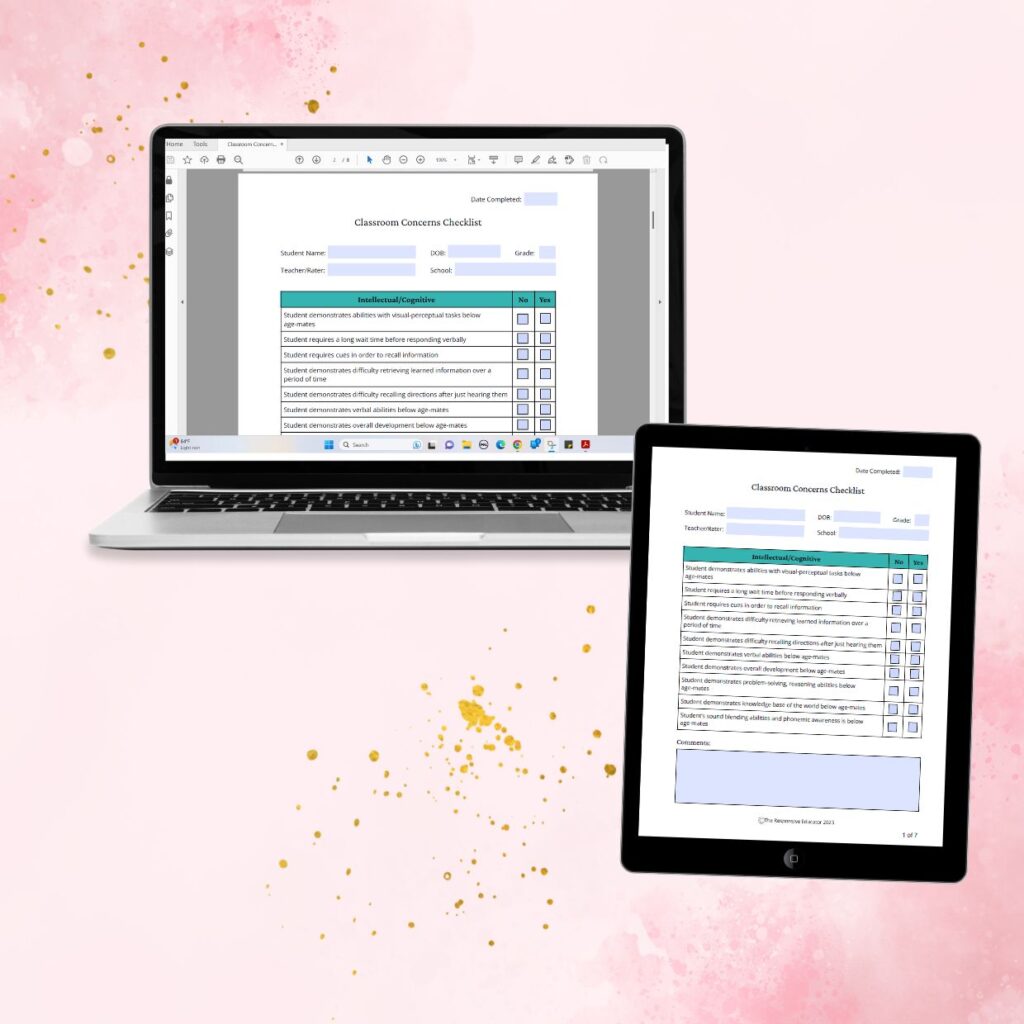

Support your students’ individual needs with our exclusive Classroom Concerns Checklist.
Identify key concerns in areas like cognitive skills, communication, social/emotional behavior, and more.
Sign up now to receive instant access and valuable insights on addressing classroom concerns.
Don’t miss out, join our community today!